The 10 Most Comprehensive FREE Shed Roof Plans Available Online
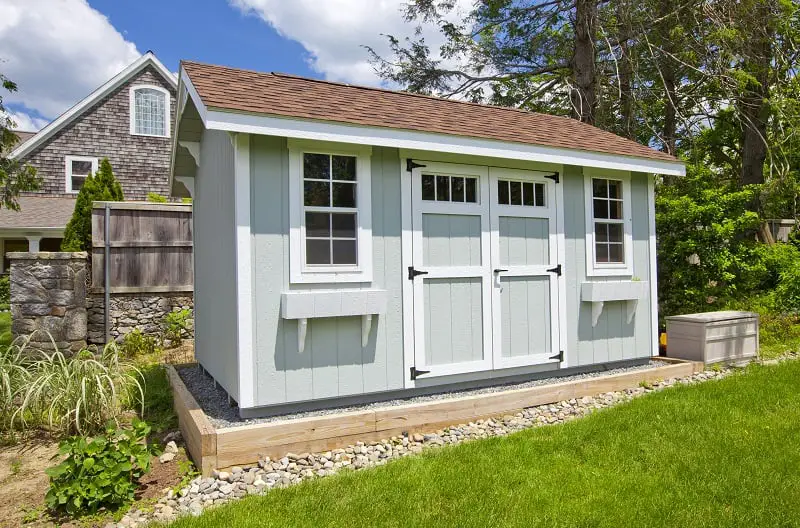
The Sky's the Limit if You Have a Roof Over Your Head
Quick Navigation
IF YOU ARE BUILDING YOUR OWN shed, you should probably consider a number of different shed roof plans before making your final decision. A roof is so much more than a way to keep the contents of your shed clean and dry.
The right shed roof design will not only keep out the elements, it can provide you with a significant amount of extra storage space. I spent countless hours looking at the many different designs before settling on a gambrel style roof so that I could get the most storage in the least space.
10 Comprehensive FREE Shed Roof Plans
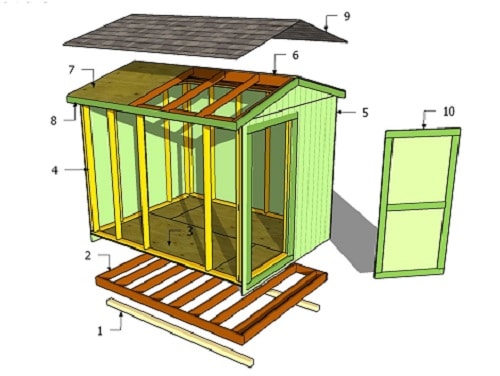
Image courtesy of gardenplansfree.com
1. The Standard Gable Style Pitched Roof
This is the most common style of shed roof
The gable style pitched roof is not only one of the most common styles of shed roof, but it is also one of the easiest to build. The first thing you need to do is determine the correct pitch for your area. This is based on how much rain and snow you are likely to get in an average year. If you know the rise and run of your roof, you can use this shed roof pitch calculator to help determine the correct pitch.
You should also contact your local building inspector to see if there are specific regulations in place governing the pitch of your shed roof. You can then use this information to modify the shed roof plans to meet these specifications and ensure your shed roof will hold up to whatever Mother Nature has to throw at it. The good news is that you can top this style of roof with roofing felt, shingles, or sheet metal with equal effectiveness.
Here is a video of a Gable Styled Pitched Roof being built:
Pros | Cons |
|---|---|
Sheds rain, snow, ice easily | May not be best suited to areas where high winds and hurricanes occur |
Offers more space for an attic | Poor construction or inadequate framing can lead to the roof collapsing |
Simple and less expensive to build than many other shed roof styles | High winds can cause the shingles, felt, or sheet metal to peel away |
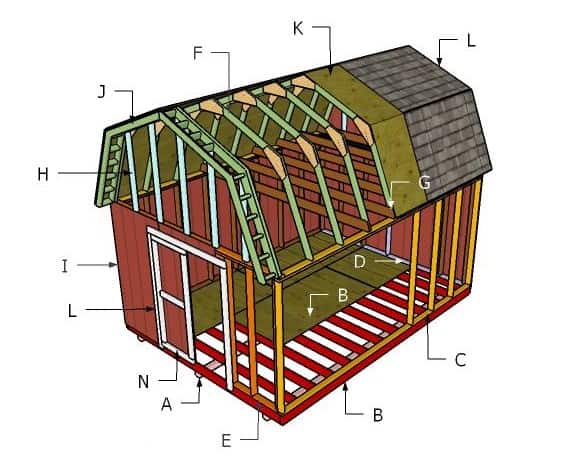
Image courtesy of Myoutdoorplans.com
2. The Gambrel or Barn Style Shed Roof
This is my personal favorite as it adds a lot of overhead storage space
Most of us have seen a number of old-fashioned barns with their tall roofs that have multiple slopes to them. What you may not realize is that this gambrel style of roof was not designed as a fashion statement. It was in fact created to build a roof that could stand up to the snows of deep winter found I many parts of the world. Although the general layout of the rafters might not seem to be that strong, the leveraged design makes them far stronger than they look.
Having two differing slopes allows rain and snow to slide off the roof and onto the ground. At the same time, the steeper sides of the roof give you a lot more usable storage space, especially for taller items. Like the gable style roof, this one is relatively easy to build and can be sheathed in wood and covered with shingles or sheet metal for added protection and durability.
Take a look at this how-to video:
Pros | Cons |
|---|---|
This style of roof offers plenty of extra space for storage without added expense | Not recommended for areas of high wind or those with heavy snowfall |
Simple construction with two roof beams and a series of gusset joints | If not constructed properly tend to be structurally weak |
Fewer materials mean lowered construction costs | Need to be waterproofed at the ridges to prevent leaks regularly |
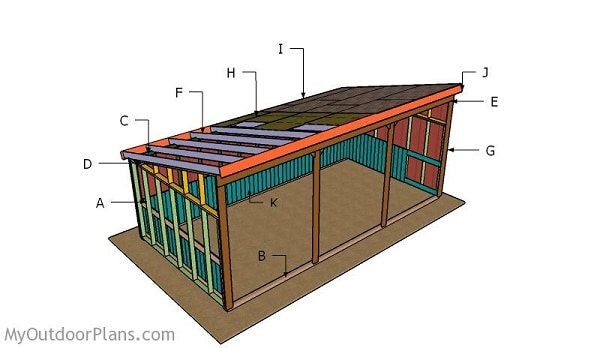
Image courtesy of Myourdoorplans.com
3. Single Slope Shed Roof
Probably one of the simplest shed roof designs out there
This style of roof is commonly referred to as a lean-to or skillion type of roof. It typically has a single face that is higher on one end than the other. Depending on where your shed is located, the higher end can be fastened to the side of another building such as your house or garage. From the outside, it looks a lot like one-half of the standard gable style roof.
What makes these shed roof plans so popular, is that they are incredibly easy to assemble and when built right, can handle a heavy snow load without collapsing. Thanks to the simplicity of this shed roof design and the size of your garden shed, you should be able to complete this roof in a single day. You can use this style of roof on a shed with 3 or 4 walls based on your needs, making it ideal for feed or firewood storage sheds.
This video goes over skillion style roof building:
Pros | Cons |
|---|---|
Very easy to build | The ceiling can end up being very low depending on the pitch of the roof |
Steeper pitch lets snow and rain run off easily | May not be best suited for areas where high winds are common |
Less expensive to build due to the need for fewer materials | May not be the most aesthetically pleasing roof |
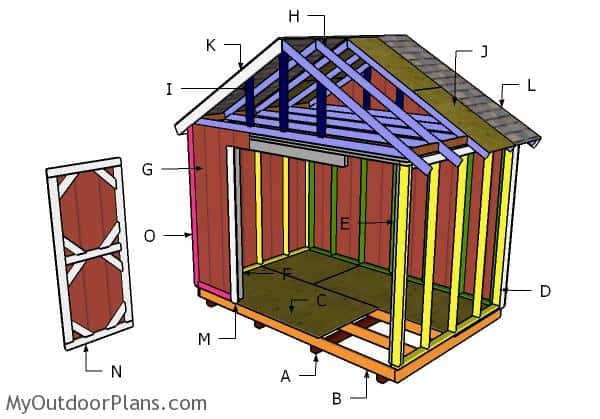
Image courtesy of Myoutdoorplans.com
4. Steeper Gable Style Roof
More pitch and a stronger design
When you live in an area where it rains or snows a lot, you need a roof with a steeper pitch and a little more slope to help prevent any snow or ice buildup. Not only does this design feature a steeper pitch (of course you can set your own pitch to meet the weather in your local area), but one that is designed in such a way as to be stronger overall.
The extra supports built into the gable ends will help add more load bearing capacity. This one also features 3/4-inch plywood sheathing covered with tar paper and asphalt shingles for added protection from the elements and structural strength. The overhanging eaves will also add a measure of protection for the walls and give you a place to add soffit vents for better ventilation.
Here is a video that shows you an easy way to build your own gable roof rafters:
Pros | Cons |
|---|---|
Sheds rain, snow, ice easily | May not be best suited to areas where high winds and hurricanes occur |
Offers more space for an attic | Needs more support for snow and ice buildup |
Simple and less expensive to build than many other shed roof styles | High winds can cause the shingles, felt, or sheet metal to peel away |

Image courtesy of Myourdoorplans.com
5. A Simple Lean-To Roof
Nothing could be easier
Of all the different types of roof, the lean-to is perhaps the easiest to build. In this case, you have nothing more than a few carefully placed rafters that are laid on top of the outer walls. The roof is typically sloped down from the connecting wall if the shed is attached to the side of your house or garage.
However, if you choose to build a freestanding shed and use this style of roof, you should plan the slope of your roof in such a manner as to slope down from the front to the back of the shed. This will help to keep rain flowing away from the door. This design uses 3/4-inch plywood sheathing, tar paper, and asphalt shingles but you could substitute metal sheeting to save money and create a very low-maintenance roof.
Lean-to roof basics video:
Pros | Cons |
|---|---|
Sheds rain, snow, ice easily | Should only be used on smaller sheds |
Easy to build | Poor construction or inadequate framing can lead to the roof collapsing |
Less expensive to build than many other shed roof styles | High winds can cause the shingles, felt, or sheet metal to peel away |
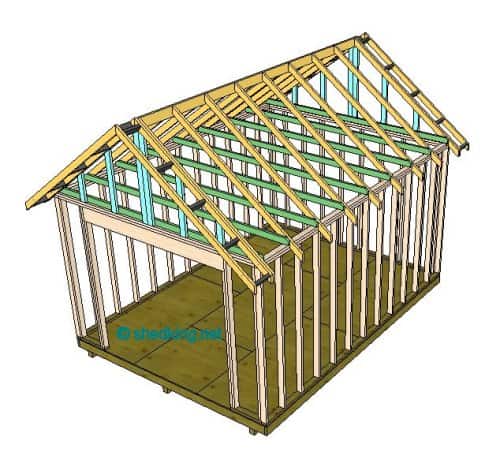
Image courtesy of Shedking.net
6. Stick Framed Gable Roof
Simple yet effective roof design
Once you have made the decision to use a gable style roof on your shed, you have one more decision to make. This is whether to build your own roof trusses, by pre-made trusses or to simply stick-frame in your roof. The typical stick frame roof will be made from 2x4's or 2x6's and has a ridge board that runs down the middle of the roof.
This type of gable roof tends to be a lot more challenging to build and may not be the best choice if your carpentry experience is minimal. However, this being said, this type of roof typically offers an overhang on the sides by virtue of the way it is constructed that lets you add in soffit ventilation.
Watch this guy build a stick built shed roof:
Pros | Cons |
|---|---|
Sheds rain, snow, ice easily | May not be best suited to areas where high winds and hurricanes occur |
Offers more space for an attic | Need to have solid basic carpentry skills to ensure all lumber is cut accurately for best results |
Less expensive to build than many other shed roof styles | High winds can cause the shingles, felt, or sheet metal to peel away |
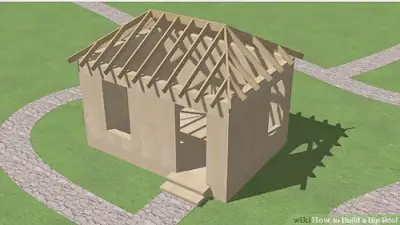
Image courtesy of wikihow.com
7. Hip Style Shed Roof
Create a roof with four slopes instead of two
While many homes and sheds feature roofs with two slopes, those that have a total of four slopes (hip style roofs) can not only be more aesthetically pleasing but also offer better snow and rain shedding ability. While this might not seem important in areas that don't get a lot of rain or snow, when you live in an area where you get heavy winter snows, you are sure to appreciate the fact your shed's roof survives each winter intact.
You can build this style of roof using premade trusses, but as long as you are comfortable with your carpentry skills, there is no reason why you should not be able to build this simple roof. This set of plans comes with its own detailed how to video that will make building it much easier for you.
Pros | Cons |
|---|---|
Excellent for areas of high wind and snow | More expensive than a gable roof to build |
Offer space for an attic | Requires more building materials than a gable roof |
More stable than a gable roof | Added seams may result in more leaks |
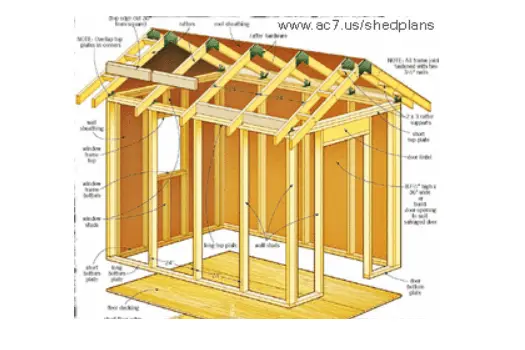
Image courtesy of dyshed.blogspot.com
8. The Saltbox Style Roof
A different take on the pitched roof
The saltbox style roof depicted in these plans offers a slightly different take on the standard gable roof design. As you can see, this design features one slope that is taller and has a steeper pitch than the other. The design does feature a gable at each end that can be used to add in ventilation in the form of vents or powered vents based on your particular needs.
The design comes from Colonial times when people needed to add more room to their homes without having to add another complete level at a high cost. It is a great choice for bigger sheds or even for a garage as it offers you the opportunity to add a lot more storage space at minimal cost.
Follow Jack as he builds a hip-style roof in this video:
Pros | Cons |
|---|---|
The dual slopes let water run off easily, perfect for areas with heavy rains | The design itself if rather tricky |
More durable than the standard gable roof | If you build a loft It will have sloping walls |
Can be built to handle moderate to heavy snow loads | May be expensive due to the number of trusses and supports needed |
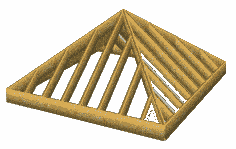
Image courtesy of Carpentry-pro-farmer.com
9. The Pyramid Style Shed Roof
Looks like it came straight out of Egypt
This style of roof looks more like something you might expect to see poking out of the desert sands of Egypt, as it has four slopes that meet in the center. Each of the four sides has a single slope that starts with a point at the top. This roof has no gables or side walls and is an excellent choice for smaller sheds and pump houses.
The overhanging eaves offer extra protection and a chance to add in soffit vents to help keep your shed cooler in the summer months. However, like the stick-built gable roof, this one can be more challenging to build as you will not be able to use any type of pre-built roof truss. Given the height of your finished roof, you should check with your local authorities to make sure it is not too high to meet code.
Check out this cool Jack Rafters video:
Pros | Cons |
|---|---|
Good choice for use in areas with high winds | Requires more building experience |
Extra space adds more storage | Higher costs due to complex design |
High slopes are good for areas with heavy rain and snowfall | Top may be too high for certain building code restrictions |
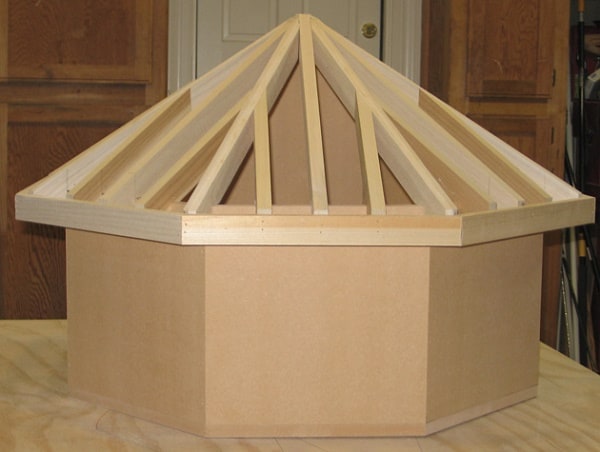
Image courtesy of Sbebuilders.com
10. Octagon Style Roof
When you want something a little different
No one ever said your garden shed had to be square or rectangular in shape. If you are looking for something a little different, why not build an octagon shaped shed. You might be surprised at how much extra space this shape can provide. It is also a great way to make use of a corner spot out in your garden. However, as you can imagine an octagon shed needs an octagon shaped roof.
This design goes together in a similar fashion to the pyramid shaped roof, but instead of four slopes, you will end up with eight. It may be one of the most complex roofs to build and should only be attempted if you have advanced woodworking skills because there are a number of critical angles that have to be measured and cut to achieve the right shape and structure. This being said, once completed, you will have a very strong roof that can take a lot of snow weight.
Pros | Cons |
|---|---|
Great for areas with high winds | Requires more building experience |
Nice change from standard roofs | Higher costs due to complex design |
High slopes are good for areas with heavy rain and snowfall | Top may be too high for certain building code restrictions |
When the Final Shingle Is Laid
Choosing the right shed roof plans for your shed can be challenging as there is so much to consider. First and foremost, you need to consider your carpentry skills. As you can see some of these designs require advanced skills to construct. Other considerations include your local building codes and the type of weather including rain, snow, and wind you have to deal with where you live.
In the end, I settled for a standard stick-built gable roof as it met my needs and my carpentry skills. The last thing I wanted to have to do was hire a contractor to finish the job because my skills were not as good as my imagination.
If you have enjoyed reading about the different shed roof plans listed here and it helped you with your shed project, please let me know.
If you have any information you would like to see here, please contact us here.
Let everyone know you enjoyed reading this on Facebook, and Pinterest.
Thank you for reading this.
Related Articles:
